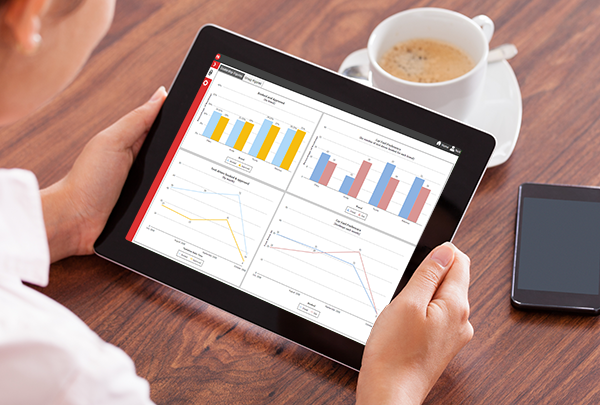Can we help your business cope with disruption from the Covid-19 crisis?
Whilst we’re in the enviable position of being able to operate pretty much as usual, we’ve seen first-hand how the current crisis is proving a massive challenge for some of our customers. We’d like to do what we can to help other organisations that are more directly affected than we are.
So, as far as our own costs allow, we’re offering a few Scottish business’s free access to our cloud analytics and forecasting platform for a few months to help ride out the crisis. Our hope is that we can help with short term financial planning or enabling staff to work from home, so local organisations are better able to survive the crisis.
Our resources are limited, and we will put in some of our own time and effort to help organisations on board, so we need to limit this offer to a few companies we think we can make the most difference with. The software works best for medium or large organisations who have enough data to make forecasting accurate or remote access challenging.
If you think this could help your organisation, please just get in touch at https://inmydata.datapa.com/about/contact-us
Playing our part in Scotland’s vibrant Data Science community
 As an analytics vendor based in Edinburgh we are not new to the world of data science. Indeed, DataPA was amongst the first software developers to enter the field of analytics over 15 years ago. In that time, we have delivered software to more than 30 thousand users in more than 300 companies, both as an embedded technology for our technology partners and as a stand-alone application to our direct customers.
As an analytics vendor based in Edinburgh we are not new to the world of data science. Indeed, DataPA was amongst the first software developers to enter the field of analytics over 15 years ago. In that time, we have delivered software to more than 30 thousand users in more than 300 companies, both as an embedded technology for our technology partners and as a stand-alone application to our direct customers.
Throughout that time, innovation has always been at the core of what we do. In recent years we have been building on the developments in big data processing and machine learning to ensure we remain at the forefront of the huge disruption we see coming for analytics software. Our goal is to use these technologies to automate the role of the business analyst, reducing the cost and failure rate for analytics implementations. Our first commercial product from this research went live with a customer in January, marking the start of a long road of development and innovation.
So, we are hugely excited about the leading role Scotland is playing in the development of data science. The vibrant academic and business environment attracting talent from across the world, with the support of the Scottish Government and great organisations like DataLab are the perfect environment for companies like ours to flourish. For us, DataSummit18 is an ideal opportunity to showcase what we have been working on and learn from the international talent that the event attracts. If you are going to be at DataSummit18, please stop by out stand. We have lots of real world experience to share and are hungry to learn from others in the data science community.
The Democratization of Big Data and Artificial Intelligence
 The market chatter about Big Data and AI is relentless. For Big Data, the statistics that many of us in the tech industry see bandied about are certainly eye catching; 2.7 Zetabytes of data exist in the digital universe today, 571 new websites are created every minute of the day, by 2020 business transactions on the internet will reach 450 billion per day etc. For AI, they are no less impressive; there was more than $300 million in venture capital invested in AI startups in 2014, a 300% increase over the year before; by 2018, 75% of developer teams will include AI functionality in one or more applications or services; by 2020, 30% of all companies will employ AI to augment at least one of their primary sales processes etc.
The market chatter about Big Data and AI is relentless. For Big Data, the statistics that many of us in the tech industry see bandied about are certainly eye catching; 2.7 Zetabytes of data exist in the digital universe today, 571 new websites are created every minute of the day, by 2020 business transactions on the internet will reach 450 billion per day etc. For AI, they are no less impressive; there was more than $300 million in venture capital invested in AI startups in 2014, a 300% increase over the year before; by 2018, 75% of developer teams will include AI functionality in one or more applications or services; by 2020, 30% of all companies will employ AI to augment at least one of their primary sales processes etc.
However, for many people not directly involved in the tech industry or the IT department of a huge multinational it’s difficult to see how these grandiose claims have any relevance to their day to day tasks. The real issue is, until recently, to do anything innovative with big data or AI you needed highly skilled data scientists versed in seemingly impenetrable technologies like NoSQL, R, MapReduce or Scala. And these guys are hard to come by and expensive, and not getting cheaper. IBM predicts that demand for data professionals in the US alone will reach 2.7 million by 2020.
However, that’s not the complete picture. Much in the same way computers began entering the business world as the preserve of large corporations like J Lyons & Company and the U. S. Census Bureau, were later more widely used as companies that could afford the huge cost of buying them provided services to others, and finally the productization of computers by the likes of IBM allowed almost every organisation to buy their own, Big Data and AI are going through the same process of democratization.
The major three Cloud data providers Microsoft, Google and Amazon are amongst a host of providers that now offer scalable and affordable Big Data platforms that can be spun up in seconds. In the last few years all three have also started offering API driven AI services bound into their cloud platforms. More importantly, those Big Data platforms and AI API’s are now becoming easily accessible to more traditional development environments like .NET. This means that millions of traditional developers can now leverage Big Data and AI without leaving the comfort of their familiar development environment.
The natural consequence of this will be an explosion of products that leverage Big Data and AI technologies available to even the smallest organisations, allowing the huge opportunities to filter down to all. In fact, here at DataPA we have spent the last twelve months working hard on a new automated analytics product leveraging Big Data and AI techniques, which we are hugely excited about launching in the coming months. The world is on the cusp of huge change that historically will rival the industrial revolution, and we are excited about sharing that journey with all our customers and partners in the coming months and years.
A quick guide to building great dashboards
The guiding principal when designing any dashboard should be to ensure your users understand key information at a glance. Ideally, a user taking their first look at your dashboard should be able to understand key information within a few seconds. Achieving this is not rocket science, simply applying a few simple principles to your decision making will transform your dashboards.
First off, make sure your dashboard is focused. If I’m looking at a dashboard that contains information for five different roles in the organisation, I need to filter out or navigate round views for all the others to get to the information that is relevant to me. That’s going to take more than a few seconds. Step one of building a dashboard should be to decide who the dashboard is for and to understand in detail what information is key to their performance. Limit your dashboard to just this information. Remember, five simple dashboards are always more useful than one complex one.
Next, always avoid clutter. The more complex the view you offer the user, the longer it will take for them to glean the information they require. Carefully consider every object and ask yourself “do I really need this? Is the information this object represents unique and important?”. If not, it’s just clutter, get rid of it.
A little more daunting at face value, but simple in practice, is the concept of using visual clues to help the user quickly recognise what they are looking at. There are two principles of design that are particularly useful with dashboards, similarity and proximity. Let’s take similarity first. Say I have a sales dashboard that shows total sales and profit in several different charts, say by sales rep, region and date. Design principles tell us that things that are similar are perceived to be more related than things that are dissimilar. As such, if I make sure that total sales is always plotted in blue and profit in green, the user is likely to recognise these values across the different charts quickly, without having to read the legend. This principle applies to more than just colour. For instance, I may always plot charts that show sales over time as line charts, sales by region as bar and sales by person as column. A second design principle, proximity, tells us things that are close to one another are perceived to be more related than things that are spaced farther apart. Implementing this is simple, make sure you place objects that are related close together, giving the user another visual clue as to their meaning.
The final tip for creating great dashboards is to think about when the data needs to be refreshed, and let this inform the design of your dashboard. An operational dashboard is likely to require real time data, so keep it simple so it updates fast. A strategic dashboard is more likely to be updated periodically, so you can afford to (and often want to) add more detail.
There are obviously many more considerations when building dashboards, not least your choice of visual objects, when and where to prepare data and much more. However, these are more particular decisions that deserve a blog in their own right. My hope is that in following the simple design principles above, you’ll quickly be creating more effective dashboards.
Copyright © 2020 DataPA Limited. All rights reserved. Privacy & Cookie Policy

